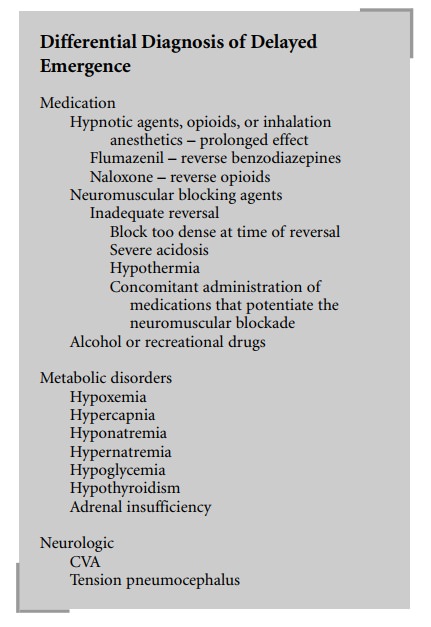Chapter: Clinical Cases in Anesthesia : Delayed Emergence, Coma, and Brain Death
How would you manage this patient in the intensive care unit?
The computed tomography (CT) scan shows a large
left thalamic hemorrhage with intraventricular blood and a mild midline shift.
The patient remains comatose. How would you manage this patient in the
intensive care unit?
· Maintain cardiorespiratory function
o
Fluid
resuscitation.
o
Vasopressors
or inotropes as needed.
o
Mechanical
ventilation.
· Decrease ICP
·
Elevate
the head 30°.

·
Avoid
positive end-expiratory pressure (PEEP), which may increase central venous
pressure (CVP) and decrease blood return from the brain.
·
Administer
mannitol (0.5–1 g/kg IV) for acute intracra-nial hypertension to raise the
serum osmotic pressure.
·
Hyperventilation
used to be routine practice. However, it has been shown to increase the risk of
brain ischemia, therefore, ventilator settings should aim at normocapnia.
Hyperventilation to a PaCO2 of 25–30 mmHg can be used if there is an
acute deterioration.
·
Consider
insertion of an ICP monitor (e.g., a ventricu-lostomy), which also permits
withdrawal of cerebro-spinal fluid in case of acute intracranial hypertension.
·
In
extreme cases, a salvage craniectomy can be performed to remove part of the
skull vault to control the ICP.
·
Avoid
rebleeding
·
Control
of the systolic blood pressure (SBP). Avoid SBP >160 mmHg.
·
Cerebral
perfusion pressure (CPP) should be main-tained >70 mmHg. CPP is calculated
by subtracting the CVP or ICP (whichever is the higher value) from the mean
arterial pressure. Although data are available only for closed head injury, the
potential for further ischemic damage in areas where autoregulation is
abolished exists with most intracranial lesions.
·
Correct
any coagulopathy.
·
Do not
use anticoagulants.
· Prevent seizures
·
Administer
fosphenytoin 1500 mg IV (equivalent to 1000 mg of phenytoin) over 30 minutes,
then phenytoin 100 mg IV every 8 hours, adjusted based on plasma levels.
·
Prevent
hyperthermia
·
While
the cerebral protective effect of hypothermia is still controversial, the
deleterious effect of hyperther-mia on the injured brain is well established.
·
Administer
antipyretics and active cooling as needed.
· Prevent gastrointestinal bleeding
·
Administer
anti-H2 agents (e.g., famotidine 20 mg IV every 12 hours).
· Prevent deep venous thrombosis
·
Sequential
compression stockings.
Related Topics